How Sandia’s paper of record evolved from employee bulletin to professional news publication

See below: Lab News editors, 1948-2020
Sandia Laboratory was still a branch of Los Alamos in November 1948 when a mimeographed newsletter identified as the Sandia Bulletin was launched. Edited by Jackie Downing, the issue did some ribbing of people — haircuts, hunting skills and dating prospects — before going on to welcome new hires, cover sports and present a small classified ad section. Much has changed in the world, at Sandia and within our communications in the succeeding seven decades, but the Lab News still publishes classified ads.
The second issue came out seven months later, identified as the Sandia Laboratory Weekly Bulletin. It had an editorial board, and publication was consistent from that point on — although it became the biweekly Sandia Bulletin in May 1950.
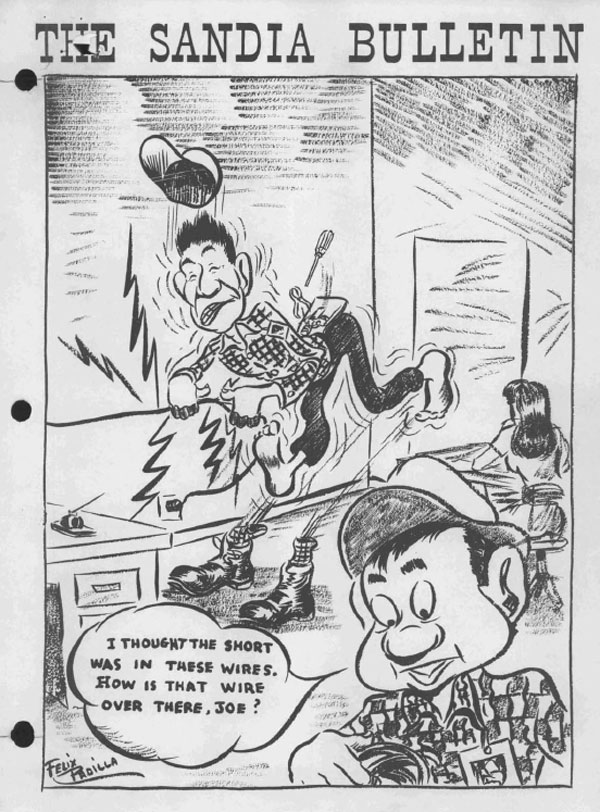
The Bulletin covered basic communication — the planning and eventual opening of the now-defunct Coronado Club, emergency preparedness, announcements, new hire welcomes — as well as news from around the departments, maintaining the light teasing of the first issue. The classified ad section grew.
After the first few issues, Felix Padilla’s cartoons filled the cover. Dec. 8, 1950, was the last mimeographed issue; two weeks later, the issue was professionally printed, and color appeared for the first time. The teasing tone evaporated, and the focus shifted toward professional achievements.
Introducing the Lab News
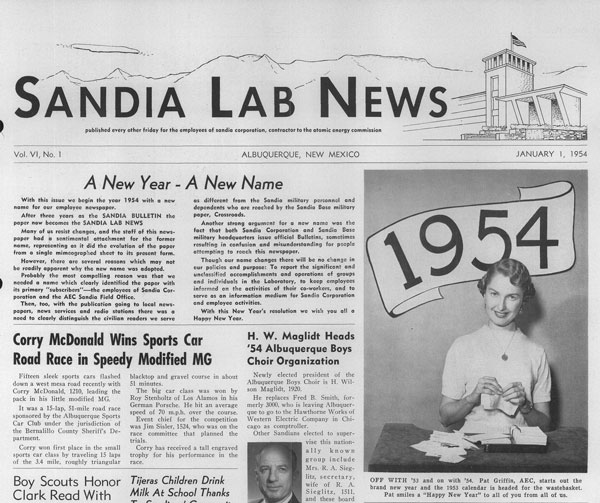
On Jan. 1, 1954, the Lab News replaced the Bulletin. The name change was primarily driven by a need to distinguish Sandia Lab from Sandia Base and this publication from other bulletins within and outside the Lab. Its focus remained on the employees — their activities and information directed at them. It has never covered news beyond the Labs, except insofar as external news intersects with Sandia and its work.
The appearance of the paper has changed over time. The image of Building 800 in the masthead from the first 1954 issue was redrawn and supplemented with the new Thunderbird logo in 1956. That design continued to change over the years, and the typeface has transformed to stay current. The use of color was intermittent until December 2000; since then all issues have been in color. Each redesign looked surprisingly new and fresh in its turn.
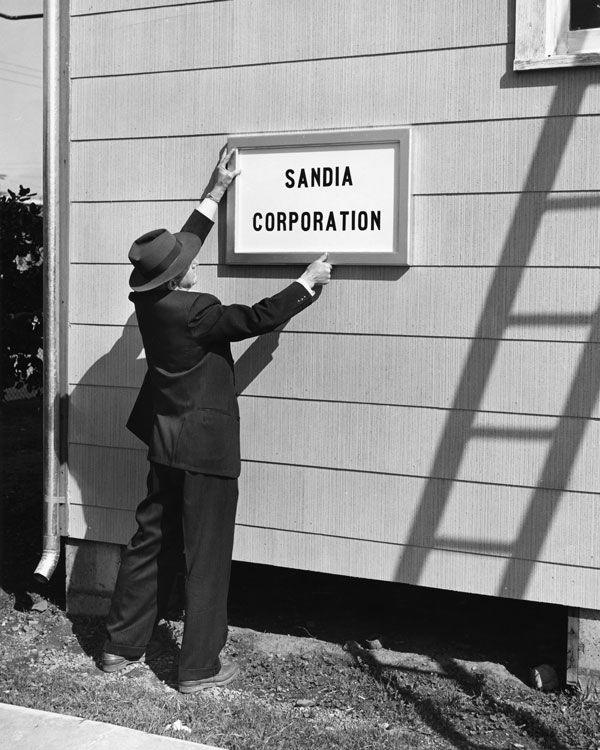
The Lab News joined the digital world in 1997, when some articles from each issue began appearing online. And beginning in December 2000, Sandia began publishing the full issues both online and on paper. Readers can still view the first digital issues in the Lab News archives.
Expansion and evolution
Inclusive of all Sandia work, the Lab News highlighted new locations as Sandia expanded in the 1950s and 1960s. After the Atomic Energy Commission decided Sandia would serve as the ordnance engineering lab supporting the University of California Radiation Laboratory, Livermore (now Lawrence Livermore National Laboratory), designs in 1956, the Lab News included Sandia Livermore’s work and human-interest stories in every issue. In 1965, Livermore News became a regular section of the paper, starting on page 3; it was re-designated Sandia California News in the 1990s.

On Aug. 17, 2007, the Lab News published its first issue entirely dedicated to the work and people at Sandia’s California Lab. The California Edition became an annual tradition that continues today.
The Lab News content also evolved with a quickly growing focus on technical work — always presenting the members of the workforce and their achievements, usually in photos with the tech. Photographing technology is not easy, but the Lab News has always had excellent photographers (see highlights from Randy Montoya’s brilliant career in Sandia’s half-life: A photo retrospective).
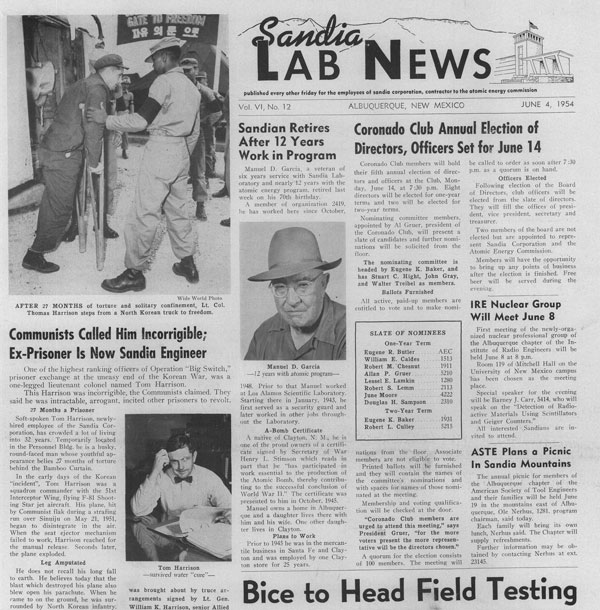
In the first few decades of the Lab News, employees’ hobbies, travels and sports teams were thoroughly covered. And, as long as the Coronado Club was open, events were advertised and covered as well. But these kinds of features gradually began to take up less space in the 1980s as Sandia undertook more unclassified work that could be openly discussed, and the Labs’ work took more of the focus.
Changing with the times
Since its beginnings, Lab News coverage has reflected the cultural assumptions of the period. For example, from 1953 (when it was still the Bulletin) through 1988, one of the December issues celebrated Christmas — the covers frequently featuring art by Sandia artists. In 1989, that practice stopped, reflecting an understanding of the various religious beliefs within the workforce.
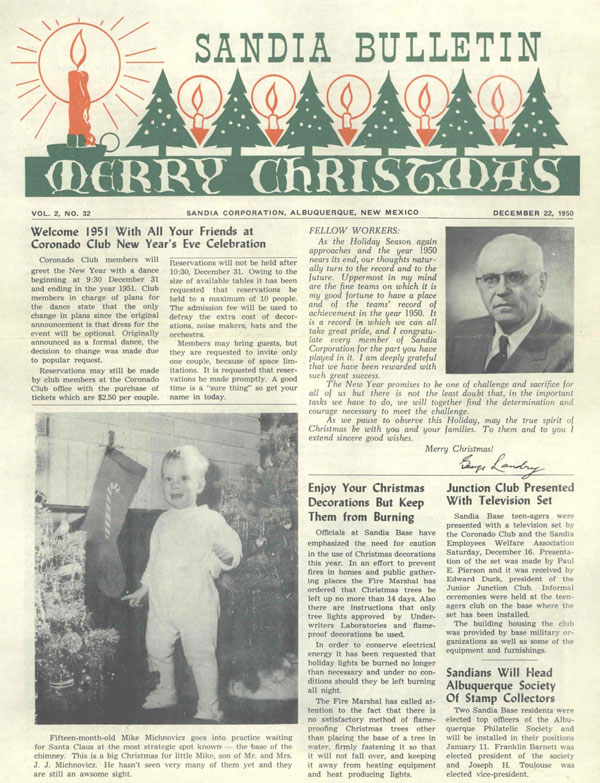
Similarly, from 1958 through January 1969, the Lab News included a safety campaign called Take a Memo, Please, in which a short safety warning — be courteous when driving in parking lots, wear your safety goggles — was printed below a photo of a woman employee with a steno pad sitting on a stool, legs crossed at the ankle. For years, announcements of the Coronado Club’s pool opening included photos of women employees in swimsuits, and in later years, men in swimsuits were included in the photos in response to women employees’ complaints. The Lab News has long since become more attentive to presenting women as professionals in all types of careers.
As much as it has changed, however, Lab News coverage also remains consistent in some ways — patents awarded, individual awards and recognition from professional societies, successful weapons tests, new leadership stepping into place, new facilities under construction while old ones are renovated.
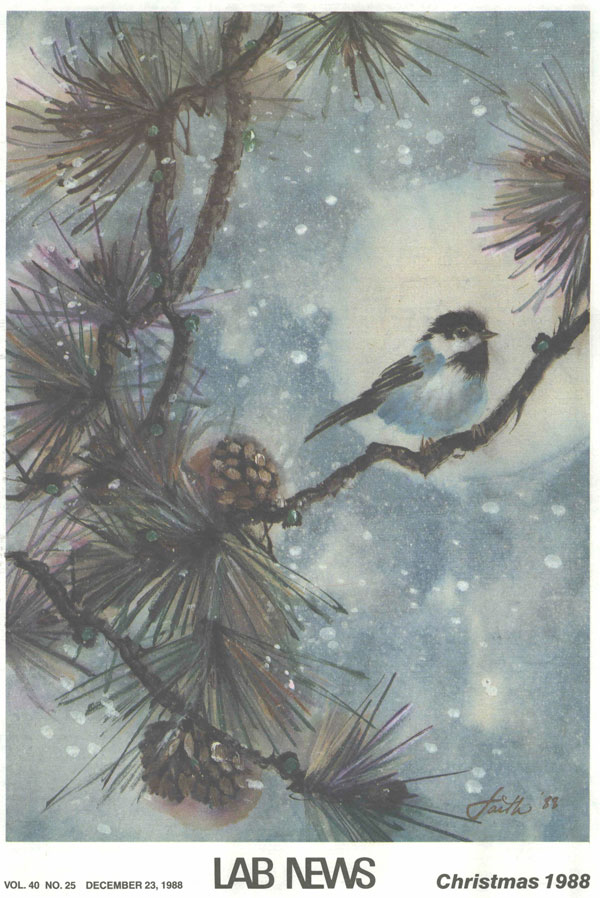
Strikingly consistent is the coverage of veterans entering the Sandia workforce — it goes back to the beginning, when World War II and Korean War vets joined the Lab, and echoes through the decades to recent articles on veterans from the conflicts in Afghanistan and Iraq.
Features become traditions
The Lab News also introduced practices that we now take for granted as traditions. In January 1970, editor John Shunny interviewed Labs Director John Hornbeck. The opening question was “How would you describe the ‘state of the union’ — Sandia Laboratories?” This proved the start of the annual State of the Labs, which has remained an interview of the top executives while also evolving into a presentation by the Labs Director providing an overview of what has gone well for Sandia over the preceding year, and where its challenges lie.
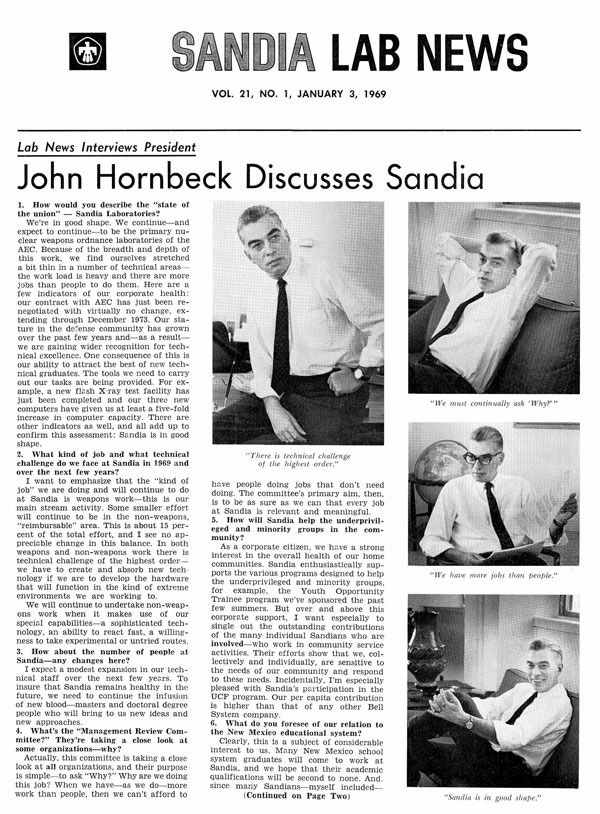
While the gentle ribbing of individual employees in the very early years of the publication evaporated in the face of more professional journalistic approaches, various editors maintained a sort of reflections column in which they commented on some Labs practices as well as the persistent belief outside of New Mexico that the state is not within the U.S.
Never overtly critical, beginning with John Shunny’s Afterthoughts in 1982, through Bruce Hawkinson’s Antojitos, Larry Perrine’s This & That, Ken Frazier’s What’s What, and Bill Murphy’s That’s That, the columns were an opportunity for reflection and a bit of poking fun at us watermelons.
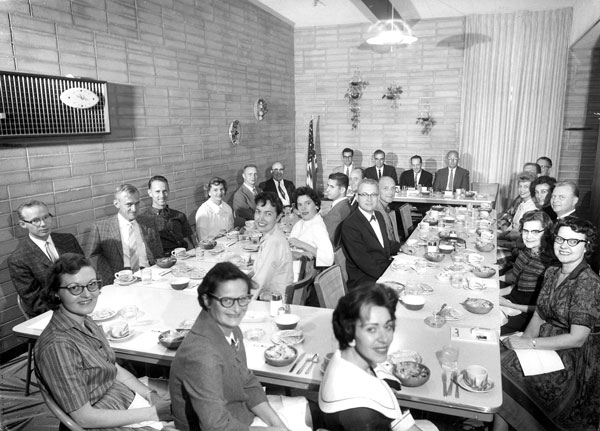
The Sandia Lab News began as a community newsletter and evolved into a significant source for informing and reflecting the Sandia community. More celebratory than introspective, the Lab News consciously places the Labs workforce at the center of every article. Its appearance, coverage and tone have evolved, reflecting changes in the workforce and its culture. Now, in 2020, the pandemic has pushed more of our work and communication online; the Lab News is coming right along with us.
Related content:
Lab News editors
| 1948 | Jacqueline Downing |
| 1949 | Editorial Board: R. B. Powell, J. L. Hickey, S. Langenstein, V. Harris, W. Bramlett |
| 1949-1951 | Jacqueline Downing |
| 1951-1965 | Robert Gillespie |
| 1965-1967 | Bob Colgan |
| 1967-1968 | Thomas Heaphy |
| 1968-1982 | John Shunny |
| 1982-1989 | Bruce Hawkinson |
| 1989-1995 | Larry Perrine |
| 1995-2006 | Ken Frazier |
| 2006-2018 | Bill Murphy |
| 2018-2019 | Jim Danneskiold |
| 2019-2020 | Tim Deshler |